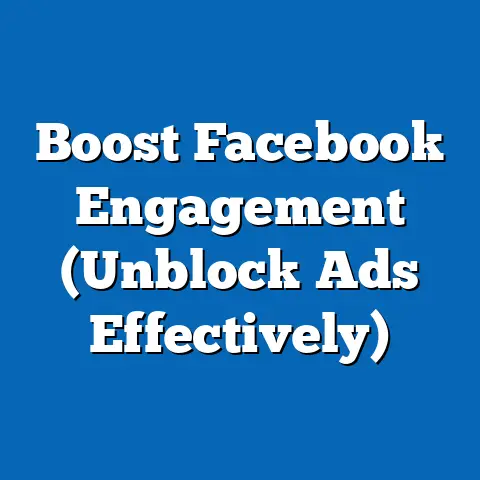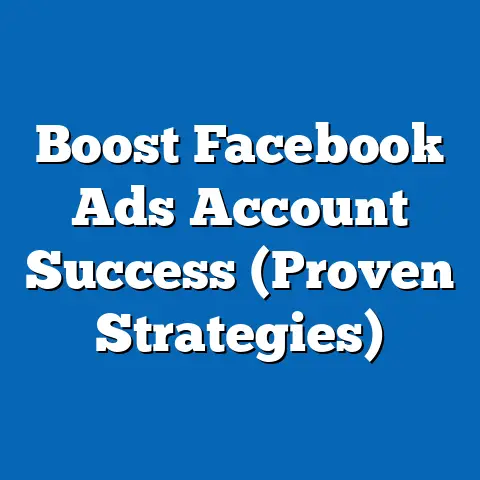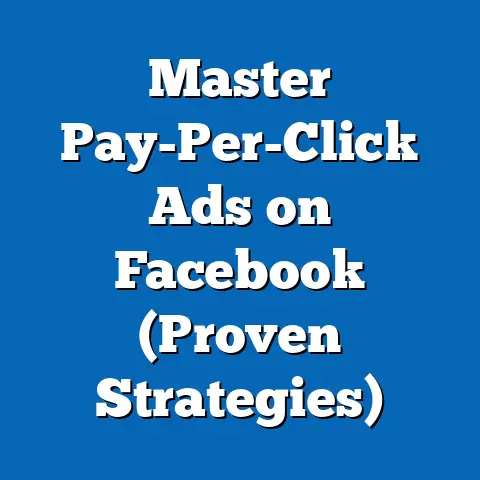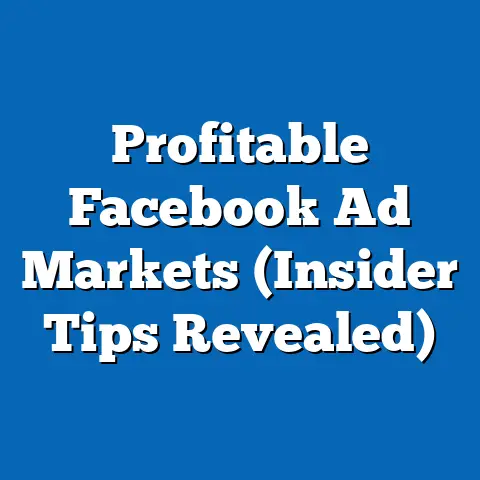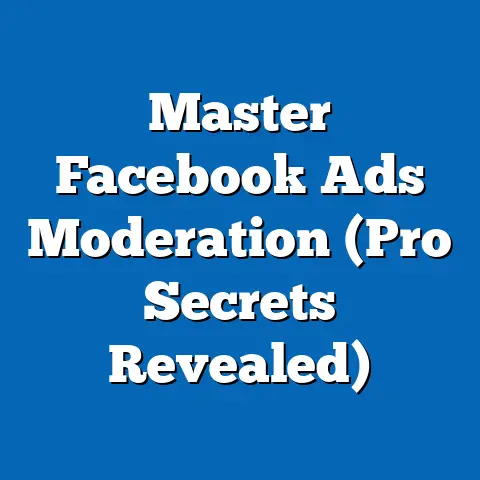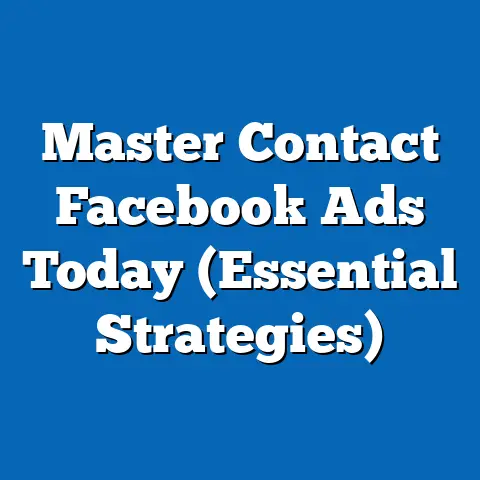Mastering Sign-Up Facebook Ads (Proven Strategies Revealed)
Have you ever wondered how effortlessly some brands seem to grow their community and engage their audience on Facebook? It’s not magic; it’s often a well-crafted strategy that leverages the power of sign-up ads. In today’s digital landscape, where consumers are bombarded with information, the ability to cut through the noise and connect with potential customers on a personal level is more critical than ever. And that’s where understanding your audience’s lifestyle comes into play.
Lifestyle marketing isn’t just about selling products; it’s about enhancing the customer experience by aligning your brand with their values, interests, and aspirations. Think about brands like Patagonia, which champions environmentalism, or Nike, which inspires athletes of all levels. They’ve built loyal communities by understanding and catering to a specific lifestyle. Effective advertising, therefore, isn’t just about pushing products; it’s about telling stories, creating connections, and adding value to people’s lives.
One of the most powerful tools for businesses seeking to expand their reach and connect with potential customers is the humble sign-up ad on Facebook. I’ve seen firsthand how a well-designed sign-up campaign can transform a struggling business into a thriving one. It’s not just about collecting email addresses; it’s about building a relationship, fostering loyalty, and ultimately, driving sales. I remember working with a local bakery that was struggling to attract new customers. They had amazing products, but their marketing was outdated. After implementing a targeted sign-up ad campaign offering a free cookie to new subscribers, their email list exploded, and their in-store traffic increased dramatically.
Section 1: Understanding Facebook Ads and Sign-Up Campaigns
Before we dive into the specifics of sign-up ads, let’s take a step back and understand the broader landscape of Facebook Ads. Facebook Ads is a powerful advertising platform that allows businesses to reach a massive audience with targeted messages. With billions of active users, Facebook offers unparalleled opportunities for businesses of all sizes to connect with potential customers.
There are various types of Facebook Ads available, each designed for a specific purpose. These include:
- Image Ads: Simple ads featuring a single image.
- Video Ads: Engaging ads that use video to capture attention.
- Carousel Ads: Ads that showcase multiple images or videos in a scrollable format.
- Collection Ads: Ads that allow users to browse and purchase products directly from the ad.
- Lead Ads: Ads specifically designed to collect leads, such as email addresses and phone numbers.
- Instant Experience Ads: Full-screen, mobile-optimized ads that provide an immersive experience.
While all these ad types can be effective, our focus today is on sign-up ads, also known as lead ads. These ads are specifically designed to collect contact information from potential customers, typically through a simple form that users can fill out directly within the Facebook platform.
The Importance of Sign-Up Ads
Why are sign-up ads so important? Simply put, they are a direct route to building your email list, increasing subscribers, and boosting leads. Here’s a breakdown of the key benefits:
- Building an Email List: An email list is a valuable asset for any business. It allows you to communicate directly with your audience, nurture leads, and promote your products or services. Sign-up ads make it easy to grow your email list by capturing contact information from interested users.
- Increasing Subscribers: Subscribers are people who have actively chosen to receive updates and content from your business. They are more likely to be engaged with your brand and make purchases. Sign-up ads can help you attract new subscribers by offering valuable incentives and showcasing the benefits of joining your community.
- Boosting Leads: Leads are potential customers who have expressed interest in your products or services. Sign-up ads can help you generate high-quality leads by targeting users who are most likely to convert into paying customers.
I’ve seen many businesses struggle with traditional marketing methods, such as print ads or cold calling. These methods are often expensive and ineffective. Sign-up ads, on the other hand, offer a cost-effective and highly targeted way to reach potential customers and generate leads.
The Psychology Behind Sign-Up Ads
To truly master sign-up ads, it’s important to understand the psychology behind them. Why do people sign up for email lists? What motivates them to share their contact information? Here are some key factors to consider:
- Incentives: Offering a valuable incentive is one of the most effective ways to encourage sign-ups. This could be a free ebook, a discount code, a free trial, or access to exclusive content. The incentive should be relevant to your target audience and align with your brand.
- Value Proposition: Clearly communicate the value that subscribers will receive by signing up. What are the benefits of joining your email list? Will they receive exclusive deals, helpful tips, or early access to new products? Make sure your value proposition is clear and compelling.
- Trust and Credibility: Build trust with your audience by showcasing your expertise and demonstrating your commitment to providing valuable content. Include testimonials, social proof, and guarantees to reassure potential subscribers that you are a trustworthy source of information.
- Ease of Use: Make it as easy as possible for users to sign up. Use a simple form with minimal fields and ensure that the sign-up process is quick and seamless. The less friction, the more likely people are to complete the process.
Statistics and Case Studies
The effectiveness of sign-up ads is well-documented. Here are some statistics and case studies that illustrate their power:
- According to HubSpot, email marketing generates \$42 for every \$1 spent, making it one of the most cost-effective marketing channels. Sign-up ads are a great way to build your email list and take advantage of this high ROI.
- A case study by Neil Patel showed that using lead magnets in sign-up ads can increase conversion rates by as much as 400%.
- Many businesses have reported significant increases in leads and sales after implementing targeted sign-up ad campaigns on Facebook.
Takeaway: Sign-up ads are a powerful tool for building your email list, increasing subscribers, and boosting leads. By understanding the psychology behind sign-up ads and offering valuable incentives, you can create highly effective campaigns that drive results.
Next Steps: Identify a valuable incentive that you can offer to potential subscribers. Define your value proposition and clearly communicate the benefits of joining your email list.
Section 2: Crafting Compelling Ad Copy
Ad copy is the written component of your Facebook ad, and it plays a crucial role in capturing attention, conveying your message, and driving sign-ups. Compelling ad copy should be persuasive, engaging, and relevant to your target audience.
Elements of Persuasive Ad Copy
Here are the key elements of persuasive ad copy that drives sign-ups:
- A Strong Headline: Your headline is the first thing people will see, so it needs to be attention-grabbing and compelling. Use strong keywords, ask a question, or make a bold statement to pique interest.
- A Clear Value Proposition: Clearly communicate the value that subscribers will receive by signing up. What are the benefits of joining your email list? Will they receive exclusive deals, helpful tips, or early access to new products?
- A Sense of Urgency: Create a sense of urgency to encourage immediate action. Use phrases like “Limited Time Offer,” “Sign Up Now,” or “Don’t Miss Out” to motivate people to sign up right away.
- A Call to Action: Tell people exactly what you want them to do. Use a clear and concise call to action, such as “Sign Up Now,” “Get Your Free Ebook,” or “Join Our Community.”
- Social Proof: Include testimonials, social proof, and guarantees to build trust and credibility. Show potential subscribers that others have benefited from joining your email list.
The Importance of a Strong Headline
As I mentioned, your headline is the first thing people will see, so it needs to be attention-grabbing and compelling. A strong headline can make the difference between someone scrolling past your ad and someone clicking to learn more.
Here are some tips for writing strong headlines:
Emotional Triggers and Storytelling
One of the most effective ways to resonate with your audience is to tap into their emotions and tell a compelling story. Emotional triggers can evoke feelings of excitement, curiosity, or empathy, which can motivate people to take action.
Here are some examples of emotional triggers that you can use in your ad copy:
- Fear of Missing Out (FOMO): Create a sense of urgency by highlighting the potential consequences of not signing up.
- Curiosity: Pique interest by hinting at something mysterious or intriguing.
- Empathy: Show that you understand your audience’s pain points and offer a solution.
- Excitement: Generate enthusiasm by highlighting the positive benefits of signing up.
Storytelling can also be a powerful tool for connecting with your audience. Share a personal anecdote, a customer success story, or a compelling narrative that illustrates the value of your product or service.
Examples of Successful Ad Copy
Let’s take a look at some examples of successful ad copy from various brands and break down what makes them effective:
-
Example 1: Grammarly
- Headline: “Improve Your Writing with Grammarly”
- Body: “Grammarly helps you eliminate errors and find the perfect words to express yourself confidently. Sign up for free today!”
- Why it works: The headline is clear and concise, highlighting the main benefit of using Grammarly. The body copy reinforces the value proposition and includes a clear call to action.
-
Example 2: Skillshare
-
Headline: “Unlock Your Creativity with Skillshare”
- Body: “Explore thousands of online classes in design, photography, business, and more. Get a free trial today!”
- Why it works: The headline is engaging and appeals to people who are interested in creative pursuits. The body copy highlights the breadth of available classes and offers a free trial to incentivize sign-ups.
-
Example 3: Headspace
-
Headline: “Find Your Inner Peace with Headspace”
- Body: “Headspace offers guided meditations and mindfulness exercises to help you reduce stress, improve focus, and get a better night’s sleep. Sign up for a free trial today!”
- Why it works: The headline is emotionally resonant and appeals to people who are seeking stress relief and mindfulness. The body copy highlights the key benefits of using Headspace and offers a free trial.
Example 1: Grammarly
- Headline: “Improve Your Writing with Grammarly”
- Body: “Grammarly helps you eliminate errors and find the perfect words to express yourself confidently. Sign up for free today!”
- Why it works: The headline is clear and concise, highlighting the main benefit of using Grammarly. The body copy reinforces the value proposition and includes a clear call to action.
-
Example 2: Skillshare
-
Headline: “Unlock Your Creativity with Skillshare”
- Body: “Explore thousands of online classes in design, photography, business, and more. Get a free trial today!”
- Why it works: The headline is engaging and appeals to people who are interested in creative pursuits. The body copy highlights the breadth of available classes and offers a free trial to incentivize sign-ups.
-
Example 3: Headspace
-
Headline: “Find Your Inner Peace with Headspace”
- Body: “Headspace offers guided meditations and mindfulness exercises to help you reduce stress, improve focus, and get a better night’s sleep. Sign up for a free trial today!”
- Why it works: The headline is emotionally resonant and appeals to people who are seeking stress relief and mindfulness. The body copy highlights the key benefits of using Headspace and offers a free trial.
Example 2: Skillshare
Headline: “Unlock Your Creativity with Skillshare”
Example 3: Headspace
Headline: “Find Your Inner Peace with Headspace”
A/B Testing Your Ad Copy
A/B testing is the process of comparing two versions of your ad copy to see which one performs better. This is an essential step in optimizing your ad campaigns and ensuring that you are using the most effective messaging.
Here are some tips for A/B testing your ad copy:
- Test One Element at a Time: To accurately measure the impact of each element, test only one variable at a time. For example, test different headlines, body copy, or calls to action.
- Use a Control Group: Create a control group that receives the original version of your ad copy. This will serve as a baseline for comparison.
- Track Your Results: Monitor key metrics such as click-through rate (CTR), conversion rate, and cost per lead (CPL) to determine which version of your ad copy is performing better.
- Iterate and Improve: Based on your results, iterate and improve your ad copy. Continuously test different variations to find the most effective messaging.
Takeaway: Compelling ad copy is essential for driving sign-ups. Use a strong headline, clearly communicate your value proposition, create a sense of urgency, and include a clear call to action. Don’t forget to tap into emotional triggers and tell a compelling story. And always A/B test your ad copy to optimize your messaging.
Next Steps: Write three different versions of your ad copy, focusing on different headlines, value propositions, and calls to action. Set up an A/B test on Facebook to see which version performs best.
Section 3: Designing Eye-Catching Visuals
In the fast-paced world of social media, visuals are king. They’re the first thing people notice when scrolling through their feeds, and they play a crucial role in capturing attention and conveying your message. For Facebook sign-up ads, high-quality images and videos are essential for driving engagement and conversions.
The Role of Visuals in Facebook Ads
Visuals are more than just pretty pictures; they’re a powerful communication tool. They can:
- Grab Attention: A compelling visual can stop people in their tracks and make them take notice of your ad.
- Convey Your Message: Visuals can communicate complex ideas quickly and effectively.
- Evoke Emotions: Images and videos can evoke emotions that resonate with your target audience.
- Drive Engagement: Engaging visuals can encourage people to click on your ad and learn more.
Design Principles for Effective Visuals
To create visuals that are both eye-catching and effective, it’s important to understand some basic design principles. Here are a few key principles to keep in mind:
- Color Psychology: Colors can evoke different emotions and associations. Choose colors that align with your brand and the message you want to convey. For example, blue is often associated with trust and reliability, while red is associated with excitement and energy.
- Branding Consistency: Maintain consistency with your brand’s visual identity. Use your brand colors, fonts, and logo in your visuals to create a cohesive and recognizable look.
- Clarity: Make sure your visuals are clear and easy to understand. Avoid clutter and focus on conveying a single, clear message.
- High Quality: Use high-resolution images and videos that are sharp and well-lit. Avoid blurry or pixelated visuals.
- Relevance: Ensure that your visuals are relevant to your target audience’s interests and lifestyle.
Tips for Creating Effective Visuals
Here are some specific tips for creating visuals that align with your target audience’s interests and lifestyle:
- Use Authentic Imagery: Avoid stock photos that look generic and uninspired. Instead, use authentic images that showcase real people and real situations.
- Showcase Your Product or Service: If you’re promoting a product or service, make sure to showcase it in your visuals. Highlight its key features and benefits.
- Tell a Story: Use visuals to tell a compelling story that resonates with your target audience.
- Use Video: Video is a highly engaging format that can capture attention and convey your message effectively.
- Optimize for Mobile: Remember that most Facebook users are on mobile devices. Optimize your visuals for mobile viewing by using vertical or square formats.
Examples of Brands That Utilize Visuals Successfully
Let’s take a look at some examples of brands that have successfully utilized visuals in their sign-up ads and analyze their strategies:
-
Example 1: Airbnb
- Visual: A stunning photo of a unique Airbnb property in a beautiful location.
- Strategy: Airbnb uses high-quality photos of its properties to showcase the unique experiences that it offers. The visuals are aspirational and appeal to people who are looking for adventure and travel.
-
Example 2: Sephora
-
Visual: A video tutorial demonstrating how to use a new makeup product.
- Strategy: Sephora uses video tutorials to educate its audience and showcase its products in action. The visuals are informative and engaging, and they appeal to people who are interested in beauty and makeup.
-
Example 3: Warby Parker
-
Visual: A photo of a person wearing a stylish pair of Warby Parker glasses.
- Strategy: Warby Parker uses photos of real people wearing its glasses to showcase the style and fit of its products. The visuals are relatable and appeal to people who are looking for fashionable eyewear.
Example 1: Airbnb
- Visual: A stunning photo of a unique Airbnb property in a beautiful location.
- Strategy: Airbnb uses high-quality photos of its properties to showcase the unique experiences that it offers. The visuals are aspirational and appeal to people who are looking for adventure and travel.
-
Example 2: Sephora
-
Visual: A video tutorial demonstrating how to use a new makeup product.
- Strategy: Sephora uses video tutorials to educate its audience and showcase its products in action. The visuals are informative and engaging, and they appeal to people who are interested in beauty and makeup.
-
Example 3: Warby Parker
-
Visual: A photo of a person wearing a stylish pair of Warby Parker glasses.
- Strategy: Warby Parker uses photos of real people wearing its glasses to showcase the style and fit of its products. The visuals are relatable and appeal to people who are looking for fashionable eyewear.
Example 2: Sephora
Visual: A video tutorial demonstrating how to use a new makeup product.
Example 3: Warby Parker
Visual: A photo of a person wearing a stylish pair of Warby Parker glasses.
I’ve noticed a common thread among these successful brands: they understand their target audience and create visuals that resonate with their interests and lifestyle. They use high-quality images and videos that are both eye-catching and informative.
Takeaway: Eye-catching visuals are essential for capturing attention and driving sign-ups. Use high-quality images and videos that are relevant to your target audience’s interests and lifestyle. Follow basic design principles such as color psychology, branding consistency, and clarity.
Next Steps: Create three different visuals for your sign-up ad campaign. Experiment with different images, videos, and design styles to see which ones perform best.
Section 4: Targeting the Right Audience
You could have the most compelling ad copy and stunning visuals, but if you’re showing your ad to the wrong people, it’s all for naught. Targeting the right audience is crucial for maximizing the effectiveness of your Facebook sign-up ads. It’s like casting a wide net versus using a fishing rod in a stocked pond – the latter is far more likely to yield results.
The Importance of Audience Segmentation and Targeting
Audience segmentation and targeting allow you to focus your advertising efforts on the people who are most likely to be interested in your products or services. This can lead to:
- Higher Conversion Rates: By targeting the right audience, you can increase the likelihood that people will sign up for your email list.
- Lower Advertising Costs: By focusing your advertising efforts on qualified leads, you can reduce your overall advertising costs.
- Improved ROI: By increasing conversion rates and lowering advertising costs, you can improve your overall return on investment (ROI).
Using Facebook’s Targeting Tools
Facebook offers a wide range of targeting tools that allow you to reach the ideal audience for your sign-up ads. These tools include:
- Demographic Targeting: Target users based on their age, gender, location, education, and other demographic factors.
- Interest-Based Targeting: Target users based on their interests, hobbies, and passions.
- Behavioral Targeting: Target users based on their online behavior, such as the websites they visit and the apps they use.
- Custom Audiences: Create custom audiences based on your existing customer data, such as email lists and website visitors.
- Lookalike Audiences: Create lookalike audiences based on your custom audiences. This allows you to reach new people who are similar to your existing customers.
I’ve found that the most successful Facebook ad campaigns use a combination of these targeting tools. The key is to experiment and find the combination that works best for your business.
Creating Custom Audiences
Custom audiences are a powerful tool for targeting your existing customers and website visitors. You can create custom audiences based on:
- Email Lists: Upload your email list to Facebook and target users who are already on your list.
- Website Visitors: Install the Facebook Pixel on your website and target users who have visited specific pages on your site.
- App Users: Target users who have downloaded and used your mobile app.
- Engagement on Facebook: Target users who have engaged with your Facebook page or ads.
Custom audiences allow you to reach people who are already familiar with your brand and have expressed interest in your products or services.
Creating Lookalike Audiences
Lookalike audiences are a powerful tool for reaching new people who are similar to your existing customers. Facebook uses its data to identify users who share similar demographics, interests, and behaviors with your custom audience.
To create a lookalike audience, you first need to create a custom audience. Then, you can instruct Facebook to create a lookalike audience based on that custom audience.
Lookalike audiences can be a great way to expand your reach and find new potential subscribers.
Insights on Using Demographic, Interest-Based, and Behavioral Targeting
- Demographic Targeting: Use demographic targeting to narrow down your audience based on basic characteristics such as age, gender, and location. For example, if you’re selling products for new mothers, you might target women aged 25-40 who live in your local area.
- Interest-Based Targeting: Use interest-based targeting to reach people who are passionate about topics that are relevant to your business. For example, if you’re selling fitness equipment, you might target people who are interested in fitness, health, and wellness.
- Behavioral Targeting: Use behavioral targeting to reach people who have demonstrated specific online behaviors. For example, you might target people who have recently purchased products online or who have visited websites related to your industry.
I remember working with a client who was selling organic skincare products. Initially, they were targeting a broad audience with limited success. After refining their targeting to focus on women aged 30-50 who were interested in organic skincare, natural beauty, and eco-friendly products, their conversion rates skyrocketed.
Takeaway: Targeting the right audience is crucial for maximizing the effectiveness of your Facebook sign-up ads. Use Facebook’s targeting tools to reach the ideal audience for your ads. Create custom audiences based on your existing customer data and lookalike audiences to reach new potential subscribers.
Next Steps: Define your ideal target audience for your sign-up ads. Identify the demographic, interest-based, and behavioral characteristics that are most relevant to your business. Create a custom audience based on your existing customer data and a lookalike audience to reach new potential subscribers.
Section 5: Optimizing Ad Performance
Creating a great ad and targeting the right audience is only half the battle. The real magic happens when you start optimizing your ad performance. This involves continuously monitoring your ad metrics, adjusting your strategies, and making data-driven decisions to improve your results.
Understanding Ad Metrics and KPIs
Ad metrics are the data points that you can use to track the performance of your Facebook ads. Key Performance Indicators (KPIs) are the specific metrics that are most important to your business goals.
Here are some key ad metrics and KPIs to monitor for sign-up ads:
- Impressions: The number of times your ad is displayed.
- Reach: The number of unique people who see your ad.
- Click-Through Rate (CTR): The percentage of people who click on your ad after seeing it.
- Conversion Rate: The percentage of people who sign up for your email list after clicking on your ad.
- Cost Per Lead (CPL): The average cost of acquiring a new lead through your ad campaign.
- Return on Ad Spend (ROAS): The amount of revenue generated for every dollar spent on advertising.
I’ve found that focusing on CPL and ROAS is particularly important for sign-up ad campaigns. These metrics provide a clear picture of the efficiency and profitability of your advertising efforts.
Strategies for Optimizing Ad Performance
Here are some strategies for optimizing ad performance:
- Adjusting Budgets: Experiment with different budget levels to find the optimal spend for your campaign. Start with a small budget and gradually increase it as you see positive results.
- Optimizing Placements: Facebook allows you to choose where your ads are displayed, such as on the Facebook News Feed, Instagram, or Audience Network. Experiment with different placements to see which ones perform best for your target audience.
- Refining Bidding Strategies: Facebook offers different bidding strategies, such as automatic bidding and manual bidding. Experiment with different bidding strategies to find the one that maximizes your results while staying within your budget.
- Improving Ad Creative: Continuously test different ad copy, visuals, and calls to action to see which ones resonate best with your target audience.
- Refining Targeting: Continuously refine your targeting to reach the most qualified leads. Experiment with different demographic, interest-based, and behavioral targeting options.
Retargeting: Bringing Back the Unconverted
Retargeting is a powerful advertising technique that allows you to show ads to people who have previously interacted with your business, such as website visitors or people who have engaged with your Facebook page.
Retargeting can be highly effective for increasing sign-ups because it allows you to re-engage people who have already shown interest in your brand.
Here are some tips for using retargeting ads to increase sign-ups:
- Show Ads to Website Visitors: Target users who have visited specific pages on your website, such as your landing page or product pages.
- Target Users Who Have Abandoned Their Cart: If you have an e-commerce store, target users who have added items to their cart but haven’t completed the purchase.
- Target Users Who Have Engaged with Your Facebook Page: Target users who have liked, commented on, or shared your Facebook page.
- Offer a Special Incentive: Offer a special incentive, such as a discount code or a free gift, to encourage people to sign up.
I’ve seen retargeting campaigns generate incredible results for my clients. By re-engaging people who have already shown interest in their brand, they’ve been able to significantly increase their sign-up rates and drive more conversions.
Analyzing Ad Performance Data: A Step-by-Step Guide
Analyzing ad performance data is essential for making informed adjustments to your campaigns. Here’s a step-by-step guide on how to analyze your ad performance data:
- Log in to Facebook Ads Manager: Go to Facebook Ads Manager and select the ad campaign that you want to analyze.
- Select a Date Range: Choose the date range that you want to analyze.
- Review Key Metrics: Review the key metrics that are most important to your business goals, such as impressions, reach, CTR, conversion rate, and CPL.
- Identify Trends and Patterns: Look for trends and patterns in your data. Are there certain days of the week or times of day that your ads perform better? Are there certain ad creatives that are generating higher conversion rates?
- Make Adjustments: Based on your analysis, make adjustments to your campaign. This could include adjusting your budget, optimizing your placements, refining your bidding strategies, improving your ad creative, or refining your targeting.
- Monitor Your Results: Continuously monitor your results to see how your adjustments are impacting your campaign performance.
Takeaway: Optimizing ad performance is an ongoing process that requires continuous monitoring, analysis, and adjustment. Track your ad metrics, experiment with different strategies, and make data-driven decisions to improve your results. Don’t forget to use retargeting to re-engage people who have already shown interest in your brand.
Next Steps: Log in to Facebook Ads Manager and analyze the performance of your sign-up ad campaign. Identify any areas for improvement and make adjustments to your campaign.
Section 6: Real-World Case Studies and Success Stories
Theory is great, but seeing how these strategies work in the real world is even better. Let’s dive into some case studies of successful sign-up Facebook ad campaigns, highlighting different industries and strategies used.
Case Study 1: A Local Restaurant
- Industry: Food and Beverage
- Goal: Increase email sign-ups to promote weekly specials and discounts.
- Strategy:
- Ad Copy: “Craving something delicious? Sign up for our email list and get a FREE appetizer with your next order!”
- Visual: A mouthwatering photo of one of their most popular appetizers.
- Targeting: People within a 5-mile radius who were interested in food, dining, and local restaurants.
- Retargeting: Users who visited their website but didn’t sign up were shown an ad with an even better incentive: a free appetizer AND a dessert.
- Results:
- Email sign-ups increased by 300% in the first month.
- In-store traffic increased by 20%.
- ROAS was 5:1.
- Key Takeaways:
- A strong incentive (free appetizer) was crucial for driving sign-ups.
- Local targeting ensured that the ads were shown to people who were likely to visit the restaurant.
- Retargeting with an enhanced offer captured those who were on the fence.
- Ad Copy: “Craving something delicious? Sign up for our email list and get a FREE appetizer with your next order!”
- Visual: A mouthwatering photo of one of their most popular appetizers.
- Targeting: People within a 5-mile radius who were interested in food, dining, and local restaurants.
- Retargeting: Users who visited their website but didn’t sign up were shown an ad with an even better incentive: a free appetizer AND a dessert.
- Email sign-ups increased by 300% in the first month.
- In-store traffic increased by 20%.
- ROAS was 5:1.
- A strong incentive (free appetizer) was crucial for driving sign-ups.
- Local targeting ensured that the ads were shown to people who were likely to visit the restaurant.
- Retargeting with an enhanced offer captured those who were on the fence.
Case Study 2: An Online Fitness Coach
- Industry: Health and Fitness
- Goal: Generate leads for their online coaching program.
- Strategy:
- Ad Copy: “Ready to transform your body and mind? Sign up for our FREE 5-day fitness challenge!”
- Visual: A before-and-after photo of a successful client.
- Targeting: People interested in fitness, weight loss, and healthy living.
- Custom Audience: Created a custom audience of people who had watched their free workout videos on YouTube.
- Lookalike Audience: Created a lookalike audience based on their custom audience.
- Results:
- Generated over 500 leads in the first two weeks.
- Conversion rate from lead to paying client was 10%.
- ROAS was 8:1.
- Key Takeaways:
- Offering a free challenge was a great way to generate leads.
- Using before-and-after photos added credibility and social proof.
- Custom and lookalike audiences allowed them to reach a highly targeted audience.
- Ad Copy: “Ready to transform your body and mind? Sign up for our FREE 5-day fitness challenge!”
- Visual: A before-and-after photo of a successful client.
- Targeting: People interested in fitness, weight loss, and healthy living.
- Custom Audience: Created a custom audience of people who had watched their free workout videos on YouTube.
- Lookalike Audience: Created a lookalike audience based on their custom audience.
- Generated over 500 leads in the first two weeks.
- Conversion rate from lead to paying client was 10%.
- ROAS was 8:1.
- Offering a free challenge was a great way to generate leads.
- Using before-and-after photos added credibility and social proof.
- Custom and lookalike audiences allowed them to reach a highly targeted audience.
Case Study 3: An E-Commerce Store Selling Handmade Jewelry
- Industry: E-Commerce
- Goal: Build their email list to promote new product launches and sales.
- Strategy:
- Ad Copy: “Discover unique, handcrafted jewelry. Sign up for our email list and get 15% off your first order!”
- Visual: A carousel ad showcasing their most popular jewelry pieces.
- Targeting: Women aged 25-55 who were interested in jewelry, fashion, and accessories.
- Behavioral Targeting: Targeted users who had recently purchased jewelry online.
- Results:
- Email sign-ups increased by 200% in the first month.
- Website traffic increased by 15%.
- Sales increased by 10%.
- Key Takeaways:
- Offering a discount on the first order was a great way to incentivize sign-ups.
- Carousel ads allowed them to showcase multiple products.
- Behavioral targeting helped them reach people who were actively looking to buy jewelry.
- Ad Copy: “Discover unique, handcrafted jewelry. Sign up for our email list and get 15% off your first order!”
- Visual: A carousel ad showcasing their most popular jewelry pieces.
- Targeting: Women aged 25-55 who were interested in jewelry, fashion, and accessories.
- Behavioral Targeting: Targeted users who had recently purchased jewelry online.
- Email sign-ups increased by 200% in the first month.
- Website traffic increased by 15%.
- Sales increased by 10%.
- Offering a discount on the first order was a great way to incentivize sign-ups.
- Carousel ads allowed them to showcase multiple products.
- Behavioral targeting helped them reach people who were actively looking to buy jewelry.
Common Traits of Successful Campaigns
After analyzing these case studies, I’ve identified some common traits of successful sign-up Facebook ad campaigns:
- A Clear Value Proposition: The ad clearly communicates the value that subscribers will receive by signing up.
- A Strong Incentive: The ad offers a compelling incentive, such as a free gift, a discount code, or access to exclusive content.
- Targeted Audience: The ad is shown to a highly targeted audience who are likely to be interested in the offer.
- Compelling Ad Creative: The ad features eye-catching visuals and persuasive ad copy.
- Continuous Optimization: The ad campaign is continuously monitored and optimized to improve performance.
Takeaway: These case studies demonstrate the power of sign-up Facebook ads when implemented strategically. By understanding the key takeaways from these success stories, you can replicate these strategies in your own advertising efforts.
Next Steps: Reflect on these case studies and identify the strategies that are most relevant to your business. Consider how you can adapt these strategies to your own advertising efforts.
Remember, mastering sign-up Facebook ads is not a one-time effort. It requires continuous monitoring, analysis, and optimization. By tracking your ad metrics, experimenting with different strategies, and making data-driven decisions, you can continuously improve your results and achieve your business goals.
I encourage you to take actionable steps based on the strategies shared in this article. Don’t be afraid to experiment with different ad copy, visuals, targeting options, and bidding strategies. The key is to find what works best for your business and your target audience.
So, what are you waiting for? It’s time to unleash the power of sign-up Facebook ads and transform your business. Go out there, create some amazing campaigns, and watch your email list grow! The potential for growth is immense, and with the right strategies in place, you can achieve incredible results. Now, go make it happen!

